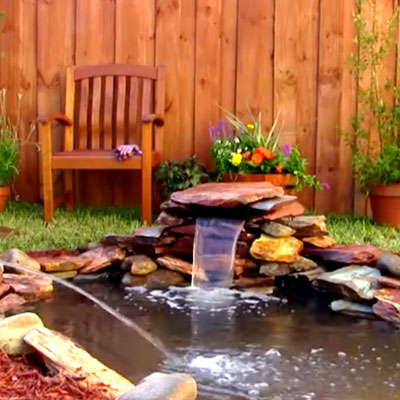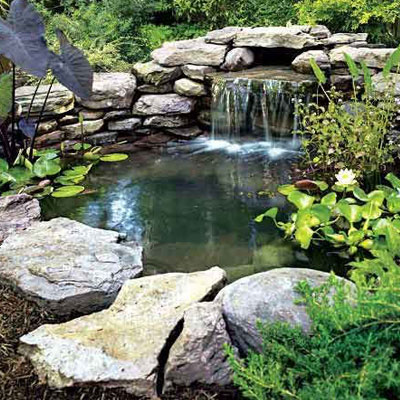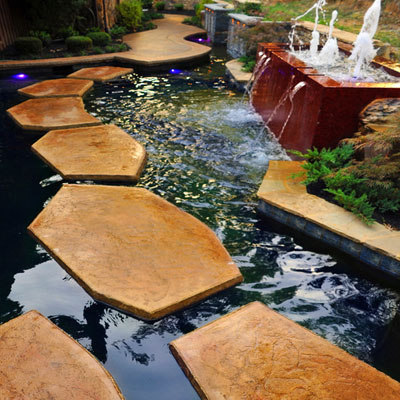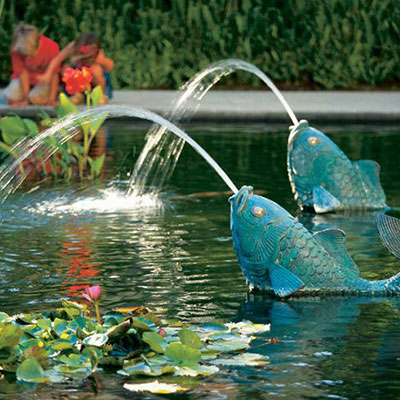If you’ve been searching for ways to give your pond a much-needed sprucing, a water feature could be just the solution. Adding a water feature can be an affordable and relatively simple way to freshen up your koi pond. Aside from looking great, water features can also help keep your koi, pond, and plants healthy.
Benefits of Water Features
The benefits of water features extend far beyond aesthetics. Waterfalls, fountains, and spitters create movement in your pond, and the movement helps encourage gas exchange. Ammonia and other toxic gases are released and oxygen is added to the pond water, which helps keep your koi happy and healthy. This aeration can also combat algae and prevent mosquitos.
Plus, who doesn’t love the gentle sound of cascading water? Aside from keeping your pond healthy, a water feature can add some tranquility to your backyard oasis, making it the perfect spot to unwind after a long day.
Types of Water Features
Waterfalls, fountains, and spitters are the three most popular types of water features. Which option is best for your pond will depend on a few factors, including your budget and the amount of time and effort you’re willing to put into the project. Also, keep in mind that no two ponds are the same–which means the exact cost and installation of your water feature will vary.
Waterfalls
Adding a waterfall spillway is a great way to give your pond a mini makeover. Of all the water feature options, waterfalls will create the most water motion. If extra aeration is your primary reason for adding a water feature to your pond, a waterfall is likely the best choice. That said, waterfalls aren’t the most economical option and installation can be time consuming, but many believe the end result is worth the effort.
The first step when building a waterfall is to decide on a design. Do you want a modern look with a gentle spillway or a more natural feel with flow similar to water rapids? Browse your favorite pond or garden social accounts, websites, and magazines to look for inspiration.

Once you’ve settled on a design, you can gather the necessary supplies. Certain supplies will differ depending on the look you’ve chosen for your waterfall. Most designs will require rocks to hide equipment and direct water to your pond, but the exact type and quantity will differ. Some waterfall designs may require additional equipment, including liner, underlayment, and gravel or sand.
Regardless of the design you’ve chosen, you’ll need a spillway, tubing, and a matching pump. You can buy these items separately or purchase them together in a waterfall kit. If you choose to purchase the equipment separately, make sure you purchase a pump that is compatible with your spillway, and tubing that is compatible with your pump. The specifications of the pump should note compatible tubing size.
Sizing a pump for a waterfall involves some math. There are some measurements you’ll need to keep in mind.
Width of Waterfall
Measure the width, or weir, of your waterfall. For a moderate flow of water, your pump should move about 100 gallons per hour (GPH) for every inch of waterfall width. For example, if your waterfall is 18 inches wide, you’ll want an 1800 GPH pump.
Elevation of the Waterfall
Measure the vertical distance from the top of your waterfall to the surface of the water. This measurement is called the head. Every 1 foot of vertical distance equals 1 foot of head height.
Length and Angle of Tubing

In addition to vertical distance, the length and angle of the pump’s tubing also needs to be included in the head height measurement. One foot of head height should be added for every 10 feet of pipe (always round up) and every 90-degree turn in your tubing. For example, a waterfall that has a vertical distance of 3 feet with 16 feet of tubing and two 90-degree turns would have a head of 7 feet. Therefore, if your waterfall is 18 inches wide, you’d need a pump that can deliver 1800 GPH at a pumping height of 7 feet.
The exact assemblage of your waterfall will depend on the design you’ve chosen. Regardless of the design, your spillway should be elevated above the water’s surface to create ample water fall.
Fountains

Fountains are a fairly simple and affordable feature to add to your pond. While you can purchase fountains specifically designed for aeration, even decorative fountains can help move the water in your pond.
Much like waterfalls, you can purchase the supplies for your fountain separately or all together in a fountain kit. To construct your fountain, you’ll need a pump and fountainhead. If you’re buying the equipment separately, you’ll want to choose the fountainhead first. Once you’ve chosen your fountainhead, you’ll need to get the appropriate sized pump. Just like with waterfalls, sizing your pump will require a few measurements.
Diameter of Fountain Outlet
Measure the diameter of the nozzle on the fountainhead. Your pump should move about 100 gallons per hour (GPH) for every inch in diameter. For example, if your fountain spout is 2 inches in diameter, you need a pump that is rated for 200 GPH.
Height of Pump to Fountain
Measure the vertical distance from the pump to the fountainhead or outlet. This measurement is the fountain’s head height. Your pump should have a max head height that is 1.5 times greater than this measurement. For example, if the fountain nozzle is 2 inches in diameter and the head height is 20 inches, you’ll need a pump that can pump 200 GPH and at a height of 30 inches.
It’s also important to take the diameter of your pond into account to ensure the water spray won’t extend beyond its boundaries. As a general rule of thumb, choose a fountain pump that won’t lift water at a height greater than half of the diameter of the pond, but be sure to follow the installation instructions on your chosen fountain.
Spitters
Decorative spitters are an easy way to add a bit of personality to your pond. With so many designs and options from which to choose, it’s fairly easy to find a spitter that fits your unique taste. Browse your favorite pond supply website to find a spitter that fits your pond aesthetic.

Once you’ve picked your spitter, you’ll need a pump and tubing to install it. In some cases, spitters will come with a compatible pump. If the spitter you’ve chosen does not come with a pump, you’ll need to buy one separately. You’ll also need to purchase the appropriate tubing to connect your spitter to the pump. The product specifications of your spitter should note the recommended pump and compatible tubing size.
Out of all the water feature options, spitters are the simplest to install. All you need to do is find a spot for your spitter on the edge of your pond and connect it to the pump.
Whether you choose to take on a large-scale waterfall project or decide to add some flare with a pond spitter, installing a water feature is the perfect way to revamp your pond. Regardless of the option (or options) you choose, your pond will look and feel better than ever.


[…] are some water features you can add to your koi pond […]